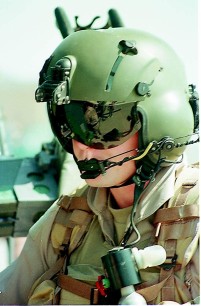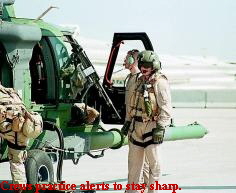|
Standing Ready In The Gulf
By Shelby G. Spires
AN AIR BASE NEAR THE
ARABIAN GULF — It's a placid day in Kuwait. Comfortable really — not at all like the stereotype of the desert. A slight cooling breeze blows in and there's no humidity in the 70-degree air.
If it weren't for all the ugly razor wire and sandbagged bunkers, then one would be tempted to break out the suntan oil and play a few rounds of volleyball. The fact that war o r a terrorist attack could happen in this foreign land at any moment tempers these nonsensical urges. r a terrorist attack could happen in this foreign land at any moment tempers these nonsensical urges.
Young men and women with the 41st Rescue
Squadron, who under normal circumstances probably would be playing volleyball or shooting hoops, walk with a steady gait around the alert pad where three HH-60G "Pavehawk" rescue helicopters are parked. They have
work to do; countless tasks are required to keep the millions of moving parts which make up a rescue operation going.
For Airman Jason Austin, 20, the days can sometimes be long and
boring. Austin, a 41st crew chief who lives in Valdosta, is responsible for making sure the helos get off the ground properly and are taken care of when they come back. The whirley birds are his babies, and he
makes sure they can fly.
"We work long days — 12 hours or so," Austin said. "That's not a bad thing, because there's very little to do here. Mostly, in my off hours,
I sleep and play Playstation."
Austin's boredom is pierced by controlled pandemonium when a technical sergeant runs across the ramp screaming the flag has gone up
for the helos to scramble. Rescue crews — maintainers, pilots, copilots and flight engineers — come streaming out of a plywood alert shack. They head to their respective choppers, tearing off canopy and engine
covers in seconds and prep are the helos for flight. Flight crews don their
gear — survival vests with equipment necessary to keep a downed pilot or aircrewman alive — and maintenance troops make the last minute checks which will ensure a safe flight for the helicopters. It
appears one had a glitch with one of the black boxes. are the helos for flight. Flight crews don their
gear — survival vests with equipment necessary to keep a downed pilot or aircrewman alive — and maintenance troops make the last minute checks which will ensure a safe flight for the helicopters. It
appears one had a glitch with one of the black boxes.
Two maintenance troops are huddled under an open forward cowling checking connectors and testing the plain black gizmos they've
been trained to recognize and care for. "It looks like one of the IFF boxes has gone bad," an airman mutters. Identification Friend or Foe is not something one wants to fly
around a potential combat zone without. A new one is found, and within 90-seconds the problem is no more; the boxes have been swapped. Fifteen minutes after the alert was given, maintenance glitches and all, the
helos are ready to be launched. It's just a test, however. Like the doctor's rubber hammer applied to the patella, the reflexes of the crews were being gauged. They passed. If the emergency had been for real the
helos would have launched, and one would have flown to rescue those in need.
"We have these tests about two or three times a week when the
crews are new," said HH-60G pilot Capt. Brian Jones. "There needed to shake out some of the cobwebs and make sure our readiness is there. After about a month or so, they fall back to maybe one a week, and
then in the end it's like one every two or so weeks."
To Austin the excitement is just part of another day in the Air Force. "It's in my family," Austin said. "My dad was in the Air Force. My
grandad was in the Army. It's in my blood. What else would I do?"
Austin's dedication typifies the spirit of a number of America's young military men and women who are a long way from home in climates
which are less than hospitable. They may not like where they are, but they realize there's opportunity. After all, they volunteered for service. "I signed up," Austin said. "There's nothing to complain about.""What
amazes me are how young and dedicated my people are," deployed 41st
C ommander Maj. Eric "Bones" Steward said. "They're some of the sharpest people I have worked with, and I'm thankful we have them to count on." ommander Maj. Eric "Bones" Steward said. "They're some of the sharpest people I have worked with, and I'm thankful we have them to count on."
At a different location — one closer to the Iraqi border called "The Rock" because it sits on a hill which overlooks Iraq — the troops of the 71st Rescue Squadron go about their daily
routine, too. An equal partner in the rescue business with the helicopter units, the 71st maintains and flies the massive HC-130 "Hercules" refueling aircraft.
The crews of the 71st sit alert too. Constantly. They're ready to launch in five-or-ten minutes. Ready to take to the skies to carry fuel for
the choppers or find a downed aircrew. It's a constant 365 day a year job for the men and women of the 71st. With 10 HC-130 aircraft assigned to the unit, two or three are always deployed either to Iceland
or Southwest Asia to meet the demands of rescue work.
"We have never been off of alert," said deployed 71st Commander Maj. Jeff Braley. "We cannot go off of alert. If we have an aircraft go
(off the schedule) for maintenance or whatever reasons, then we don't train. Our primary mission is to sit alert, and that is always in the forefront of our every day here."
A necessary part of the rescue operation, the HC-130s carry the gas to keep the choppers in the air. The refuelers effectively double the
range of a rescue helicopter and allows them to fly deep within Iraq, if need be, to pluck downed aircrew members from the clutches of an Iraqi prison or death. "We like to think they couldn't get anywhere with
us," Braley said.
However, the refuelers are more than just waterboys for the HH-60Gs. They have rescue duties. The aircraft can deploy teams of
parajumper, or PJs, by parachute. Being that the HC-130 flies about twice as fast as a helicopter it can reach survivors quickly, deploy a team, and in turn the four engined aircraft plays a major role in getting a
survivor back to safety. On a given day, when there's an ability to fly a training mission, the HC-130 crews try to cram as much activity into a single flight as possible.
They're are near the lion's den, and the better they know, then the easier it is to escape its bite.
"We try to get as much done with the time that we have as possible. The flying here is great," said HC-130 pilot Capt. Ted Ferguson.
On one such mission, Ferguson and his crew took off to join up with an HH-60G piloted by Stewart. The training sortie, carried out about 15
miles from the Iraqi border, was important because it allowed Stewart and his co-pilot 1st Lt. Jon Cary time to practice refueling in the air. About 1,500 feet off the ground, the HC-130 slows to a
speed which is dangerously close to it stall speed — the point which the aircraft would fall out of the air. by Stewart. The training sortie, carried out about 15
miles from the Iraqi border, was important because it allowed Stewart and his co-pilot 1st Lt. Jon Cary time to practice refueling in the air. About 1,500 feet off the ground, the HC-130 slows to a
speed which is dangerously close to it stall speed — the point which the aircraft would fall out of the air.
Extending a probe, the chopper pulls in smooth and takes on fuel
from a hose dragging behind the wing of the HC-130. Then it backs off. After making a few more dry runs at the refueling hose, the chopper eventually banks off and flies to rendezvous with the "downed" aircrew
members at a predetermined set of coordinates.
Meanwhile, Ferguson uses the time to practice surface-to-air missile evasion tactics. Crisscrossing Kuwait City, Ferguson puts the huge four
engined aircraft into a series of gut wrenching turns. "We use these when somebody has called out a missile is in the air," Ferguson said. "Hopefully it will fool the missile."
Ferguson's in pilot heaven this day. He's finished up with the straight and level flying, and he spends about two hours diving, zooming and quick turning the aircraft left and right. It's not very friendly on any
passengers, but if it were for real, then airsickness is preferable to being blotted from the sky by a missile.
As the sun sets on another day in the desert, Ferguson comes in for
a landing at "The Rock." It's been one more in an endless series of training missions for an Air Force crew.
|
|